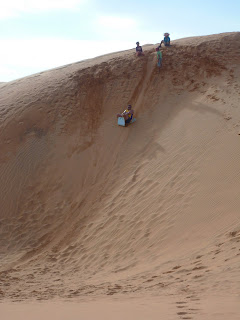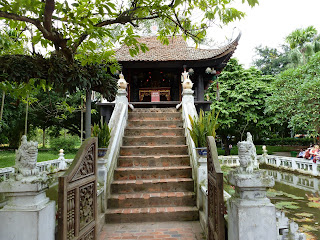Saigon, as it was formerly (and still is unofficially) known, is just as crazy, chaotic and thrill-riding as you'd expect it to be, and a fitting way to end our journey through this often intense, and at times insane, country.

Saigon is a city full of dizzying contrasts: hawkers in conical hats walking under huge, flashing billboards; ropey motorbikes roaring through the streets next to perfectly polished Hummers; timeless alleys, lined with ramshackle stalls selling spices and pans, leading to designer malls and gourmet restaurants. Yet, everyone is as much a part of this living organism as the next, adding their own energy and eclecticism to the city's urban mosaic.
Reminders of what the city and its people went through, just one generation ago, are in the tourist trappings (the museums and the Củ Chi tunnels) but today, propaganda about the Vietnam war (or, to the Vietnamese, the American war) is now only contained in the faux-vintage poster shops and group tours led by grinning guides. The American outlets of KFC and Adidas hammered home that point.
While there, we took part in the touristy propaganda - silently looking at horrific images from the war and making our way through a stifling section of the Củ Chi tunnels, an immense network of underground tunnels used by the Vietnamese (in Western history books, known as the Viet Cong guerillas) to bewilder and defeat the Americans.

At Củ Chi, we took a tour through the jungle where a lot of the Vietnam war was fought, and where a great deal of soldiers, on both sides, lost their lives. We circumnavigated bomb craters and booby traps of all kinds that were made by the communist soldiers to capture, kill or maim American fighters when on the ground. I squeezed myself into one hiding hole - not advisable if you are even a little bit claustrophobic, or "big-boned" for that matter.
The tunnels, which have been widened and reinforced for tourists in parts (not that you would know as they are so small and cramped), go deeper into the earth and the Viet Cong and civilians alike lived under there to avoid being shot or captured. We shuffled along inside, our backs bent right over
 as we made our way along in the dark and dirt. We bailed out early (you can walk 100 metres) and it was a relief to see sunlight again, I can tell you!
as we made our way along in the dark and dirt. We bailed out early (you can walk 100 metres) and it was a relief to see sunlight again, I can tell you!It must have been a terrifying life, living underground, only emerging to shoot at the enemy. So many lives were lost here and the deafening sound of the theme park style
shooting range was quite unsettling.
Another sobering day arrived when I rounded a street corner, looking for postcards, and stopped in my tracks because I was aware that there was something strange with the formation of people ahead of me. A kind traveller approached me and said "if you don't want to be depressed, don't come down here." I looked ahead and could see why everyone had stopped in their tracks. A Vietnamese man, surrounded by a huge pool of blood that was spreading onto the grey tarmac, was writhing around in the road. He had slit his throat and was slowly dying in the centre of a busy street. Stunned, and feeling wobbly, I decided to turn on my heal and leg it back the way I came.
But the image stuck with me all day and I was left wondering what would drive a person to do that so spontaneously and so publicly. That evening, we asked a local guy while sat drinking bia hơi if he knew what had happened. He said, looking very solemn, "love, I can't think of

another reason but love."
Despite their often hard exterior, the Vietnamese are a bunch of hopeless romantics after all. And we left on this note, happy we had experienced this beautiful, unruly country with its formidable, resilient and occasionally charming people, yet glad to be moving on to Cambodia for our next adventure.






 during Happy Hour(s) and keeping them in the fridge behind the bar, tucking in with our fingers to platefuls of fresh seafood, and nursing bad sunburn (not mine, for I'm still obsessed with the factor 30).
during Happy Hour(s) and keeping them in the fridge behind the bar, tucking in with our fingers to platefuls of fresh seafood, and nursing bad sunburn (not mine, for I'm still obsessed with the factor 30). We travelled south on the train to visit the cultural heart of Vietnam, Huế. Our expectations for the overnight journey were low and flashbacks from my India train travel made me a little anxious.
We travelled south on the train to visit the cultural heart of Vietnam, Huế. Our expectations for the overnight journey were low and flashbacks from my India train travel made me a little anxious.

 knee-deep river to get back to our hotel, passing by a wriggling snake (that made me walk considerably faster).
knee-deep river to get back to our hotel, passing by a wriggling snake (that made me walk considerably faster). We watched as people sent the floating candles into the gentle flow of the river to be carried away under the bewitching light of the full moon.
We watched as people sent the floating candles into the gentle flow of the river to be carried away under the bewitching light of the full moon.
 With a UNESCO World Heritage seal of approval, Ha Long Bay sits on the northern ridge of a limestone chain that sweeps up from the Gulf of Thailand and the Angthong National Marine Park. It’s not the cliffs themselves that make Ha Long Bay unique, but rather their sheer number. This huge bay is dotted with nearly 2,000 mostly uninhabited, jagged limestone islands, or karsts.
With a UNESCO World Heritage seal of approval, Ha Long Bay sits on the northern ridge of a limestone chain that sweeps up from the Gulf of Thailand and the Angthong National Marine Park. It’s not the cliffs themselves that make Ha Long Bay unique, but rather their sheer number. This huge bay is dotted with nearly 2,000 mostly uninhabited, jagged limestone islands, or karsts.






 Hawkers in conical hats ply their wares, many speaking French as well as Vietnamese; locals sip iced Vietnamese tea on the street or linger over coffee in Parisian-style cafés, watching life pass them by; ramshackle market stalls, selling anything from caged birds to coffins, line the grand, leafy boulevards.
Hawkers in conical hats ply their wares, many speaking French as well as Vietnamese; locals sip iced Vietnamese tea on the street or linger over coffee in Parisian-style cafés, watching life pass them by; ramshackle market stalls, selling anything from caged birds to coffins, line the grand, leafy boulevards.

